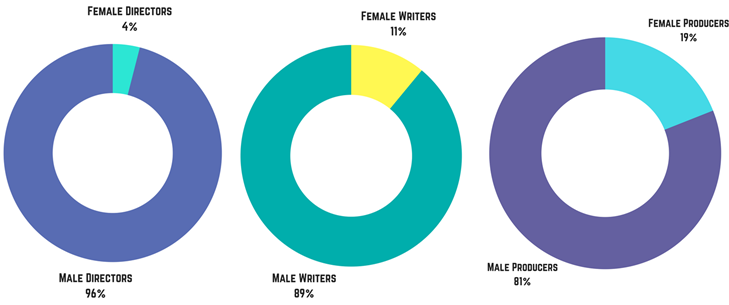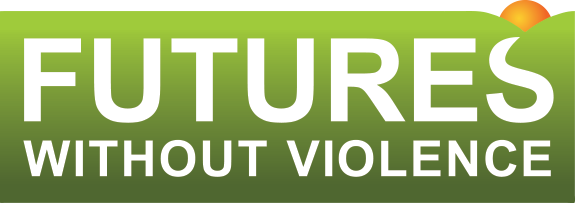In Case You Missed It, We’re Complicit: Sexual Harassment in the Workplace
Perpetrators of sexual harassment do not act in a vacuum. Harvey Weinstein certainly did not commit his decades of sexual harassment in covert isolation. It was an “open secret” for many in and outside of the industry.
Consider the co-workers who aid and abet by laughing at inappropriate sexual jokes, the board that looks the other way when rumors surface, and the human resources staff who fail to take action.
This complicit workplace culture cocoons the perpetrator and incubates the degradation and violation of women.
But think about women’s status in the film industry to contextualize this. Of the top 100 grossing films of 2016, women only represented [1]:

It is no surprise that this gender disparity is reflected in films as well [2]:
- 30.8% of speaking characters are women
- 28.8% of women wore sexually revealing clothes as opposed to 7% of men
- 26.22% of women actors perform partially naked versus 9.4% of men.
I would be remiss if I didn’t point to women’s unequal status in the U.S. in general. If you add race, socio-economic status, legal status, sexuality, and other social identifiers, you’ll see even greater power disparities and forms of oppression.
Sexual harassment is undoubtedly a symptom of a greater epidemic of gender disparity, as well as other inequities in our society.
Many people mistakenly believe that sexual harassment is primarily about sex, and so perpetrators of sexual harassment enter rehab facilities for sex addiction. But sexual harassment is about power and control; sex is only the vehicle for an assailant to exert and exercise power and control over a victim. And while high profile cases like Weinstein’s start much-needed conversations in mainstream media, we can’t forget about the swath of rapists and perpetrators who will never get the same spotlight or endure this level of public shaming.
We can’t forget the millions of victims who may never feel safe enough to report harassment or rape, whether they fear losing their jobs, other forms of retaliation, or deportation. According to the U.S. Department of Justice, about 50 people a day are sexually assaulted or raped while working. This may only be a fraction of the reality since much of this behavior goes unreported.
Complicit workplace cultures create a normalized behavior allowing sexism to flourish and sexual harassment to go unchecked. We need to change attitudes, but the heavy lifting should not be done by women alone. Men need to speak out and take action.
I salute those who already have, like Terry Crews, who shared his personal experience of sexual harassment and empathized with those who have not been able to speak up. Director Ryan Coogler’s spot-on statement reiterates that sexual harassment and assault are human rights violations and that he and others in positions of power and privilege have a responsibility to become better allies.
I know that changing norms takes time, but there are concrete steps we can take in the workplace. Here are four ways to revamp your system and change your workplace culture:
- Have a clear policy in place that addresses gender-based violence and sexual harassment, and a survivor-centered protocol for enforcing it.
- Ensure that your Human Resources team has a level of autonomy to address issues, especially with respect to personal safety and in situations where the owner or president is the perpetrator;
- Compile a list of resources that are available in the community as well as nationally (such as the National Sexual Assault Hotline number: 1-800-656-HOPE);
- Create a culture of accountability and respect. When you hear something or see something inappropriate, say something.
What can individuals do? Share some knowledge:
- Watch a documentary about toxic masculinity like “The Mask You Live In” with a male-identifying friend;
- At your next book club, read bell hooks’ Feminism is for Everybody;
- Listen to this podcast episode from Reveal (The Center for Investigative Reporting) about rampant sexual assault among janitorial workers.
I’m grateful for the brave women who have spoken up about their experiences with Harvey Weinstein. I also thank everyone who has been motivated to engage in the conversation, whether as survivors or supportive allies.
But once the Weinstein story fades from the headlines, we can’t go back to the status quo. Let’s use this momentum to continue building a movement for a safer future in the workplace and outside – one of accountability, respect, and equity.
For more information on how you can address sexual harassment in the workplace, visit the Workplaces Respond National Resource Center or contact us at workplacesrespond@futureswithoutviolence.org.
[1] Lauzen, M. 2017. “The Celluloid Ceiling: Behind-the-Scenes Employment of Women on the Top 100, 250, and 500 Films of 2016.” Center for the Study of Women in Television and Film. Available at http://womenintvfilm.sdsu.edu/wp-content/uploads/2017/01/2016_Celluloid_Ceiling_Report.pdf
[2] New York Film Academy. 2013. Gender Inequity in Film. Infographic. Available at https://www.nyfa.edu/film-school-blog/gender-inequality-in-film/#!prettyPhoto





